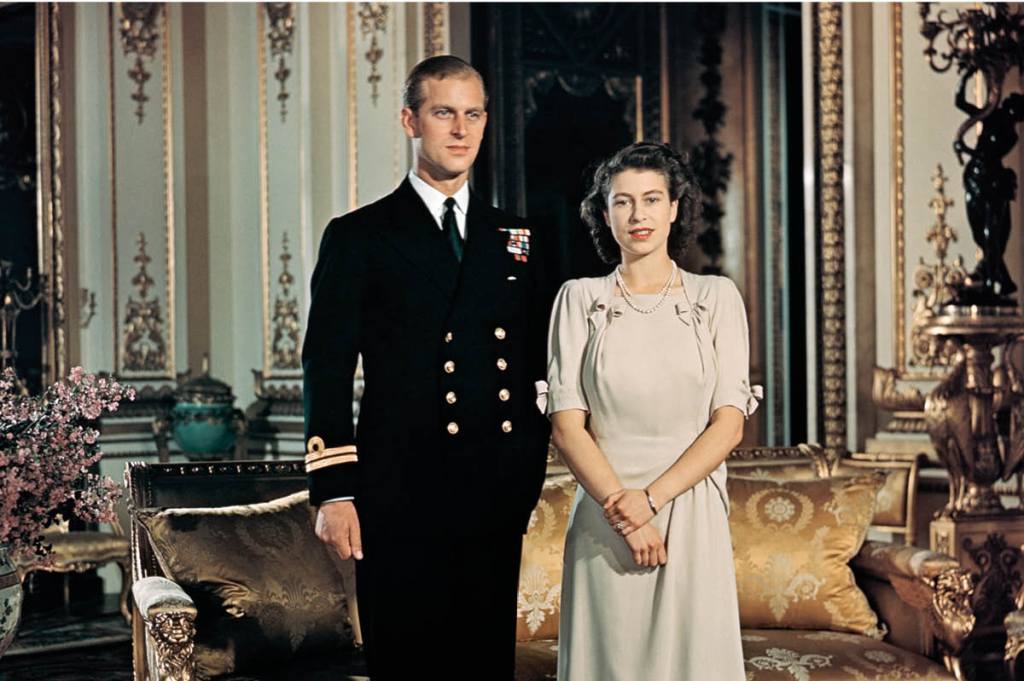Power and Glory is, as its subtitle implies, a tale of survival. In a fast-paced history of the British throne from the years 1945-53, Alexander Larman, a seasoned chronicler of the House of Windsor, depicts a dynasty reeling from the 1936 abdication of Edward VIII — “David” to intimates — and the storm of war that broke over Europe three years later. Among other family dramas, Larman deftly sketches the lives of the former king’s increasingly infirm younger brother George VI, as he attempts to balance a job he didn’t want in the first place with an almost masochistic sense of duty; that of George’s daughter, the young Princess Elizabeth, preparing for her own eventual succession while grappling with the elaborate courtship rules of the day before being allowed to marry the man she loved; and, not least, the Banquo-like specters of David and his wife Wallis Simpson, elevated to the titles of Duke and Duchess of Windsor, but, in her case, never to the full “Royal Highness” her husband felt she richly deserved, periodically returning from their French exile to wrangle with the family about money and status.
Larman’s astute pen-portraits include all the main dramatis personae, and dozens of secondary characters, among them the fawning British businessman Kenneth de Courcy, writing to the former king in 1946: “You are very much loved… There is some contact between you and the minds of the people [which] is one of those mysterious things one cannot explain, but which is exceedingly powerful.” So powerful, in fact, that de Courcy would go on to propose the establishment of two rival royal camps — a distressing prospect for the British public, but an episode which in Larman’s hands is always gripping and often darkly funny. I knew de Courcy somewhat in my youth, and can still remember him seated at the table of a grand English country house where we were both guests, declining all offers of food but doing a brisk trade with the drink decanter. Between libations, he kept up a lubricated monologue about his being bugged by the CIA, MI5 and KGB, among a whole host of other acronyms, all on account of his perfectly reasonable patronage of the still-living Duchess of Windsor. A reader need only think of one of those simultaneously sinister and comic characters out of Anthony Powell’s A Dance to the Music of Time to get some of the flavor. Larman captures de Courcy perfectly here, one of many tiny black dots meticulously filled in to get the whole picture.
The story begins on the evening of May 8, 1945, when the nineteen-year-old Princess Elizabeth, dressed in her wartime Auxiliary Territorial Service uniform, stood with her family on the balcony of Buckingham Palace, gazing out over the rapturously upturned faces of their subjects gathered below to celebrate the announcement of victory in Europe. Swept up by the euphoria of the occasion, the princess and her fourteen-year-old sister Margaret slipped out into the crowd to kick up their legs in a spirited rendition of the “Lambeth Walk” and other popular dances, possibly the closest the young heir to the throne ever came to an uninhibited display of irresponsibility and joy. For the next seventy-seven years, she remained almost unwavering in her stoic devotion to duty.
Larman’s tale picks up again with the arrival on the scene of the dashing, Corfu-born Royal Navy officer Prince Philip of Greece and Denmark, whose own background reads in part like the plot of a John Buchan novel. The grandson of the assassinated King George I of Greece, as an infant Philip had been spirited away from revolutionary cutthroats and evacuated on a British warship. His mother was later diagnosed with paranoid schizophrenia, and his father took up residence in Monte Carlo. Schooled successively in France, Germany and Britain, Philip joined the British senior service in 1939, coming to know the thirteen-year-old Princess Elizabeth when she visited the Royal Naval College, Dartmouth, a meeting engineered by Philip’s socially ambitious uncle “Dickie” — Lord Mountbatten. The young couple spent the next eight years exchanging letters before their engagement was announced in July 1947.
Curiously enough, what proved to be the longest-running royal marriage in history got off to a rocky start. As Larman sagely observes, “postwar Britain was a peculiar place,” not least in its obsessive class-consciousness. To some at court, Philip was simply below his salt: the young naval officer was foreign-born, with no money or social standing, and three of his four elder sisters had married Nazis. There was also the potentially troubling fact that he and Elizabeth happened to be third cousins through their common descent from Queen Victoria. The whole richly-layered saga — today we might call the family dysfunctional — is vividly captured here, alongside the physical atmosphere of the London of the 1940s, seemingly permanently winter-bound and sulfurously foggy, very much still the Victorian city, haunted by the past.
It’s hard not to feel sympathy for Elizabeth’s father as, in increasingly poor health, he emerged from leading his country through the war only to find himself marginalized by the arrival in July 1945 of Clement Attlee’s reforming Labour government. Where Winston Churchill had encouraged George VI to believe that he had an active role to play in the nation’s welfare, Attlee politely made it clear that the king was to restrict himself to listening and agreeing. There was evidence of the changing social landscape even in the royal household; the formerly servile domestic staff informed their employer that they would have no option but to join a union if their pay demands were not met.
On a freezing cold January morning seven years later, the king stood on the tarmac at London Airport, hat in hand, looking gaunt and ill, bidding goodbye to his daughter and son-in-law as they embarked on what was intended to be a six-month tour of the Commonwealth. Elizabeth returned just a week later, now as the queen who was destined to remain a steadying influence on the nation for the next seventy years. Her father had succumbed to a coronary thrombosis at just fifty-six.
So far so good for Larman’s tale, which has a way of conveying the mild silliness of the British royal family as an overall concept along with a sense of the ineffable melancholy of most individual royals’ lives, lending an almost Chekhovian poignance to the narrative. But what really lifts the story to the heights are those moments when the pantomime-villain figures of the exiled Duke and Duchess of Windsor return to stalk the scene. What drove David, the man who briefly became Edward VIII, to be so titanically self-centered, famously announcing that he would prefer not to rule the British Empire “without the help and support of the woman I love.” Perhaps it represented a psychological compensation for the largely loveless childhood inflicted on him and his brothers. George VI’s wife Elizabeth, the future Queen Mother, once compiled a list of hints “in case of anything happening to me” for her husband. “Remember how your father, by shouting at you, and making you feel uncomfortable, lost all your feeling,” she wrote. “None of his sons are his friends, because he is not understanding and helpful to them.”
For a few months in 1936, David had been king-emperor, ruling over a worldwide dominion of some 400 million people. Just ten years later, after an unhappy stint as governor of the Bahamas, he was a jobless, stateless idler, reduced to selling monogrammed cigarettes on the streets of San Remo in order to buy meat. In best Agatha Christie style, Larman recounts the tragicomic events that followed in October 1946, when the Windsors were visiting their friends the Earl and Countess of Dudley at their home outside London, and a party or parties unknown took the opportunity to relieve the duchess of jewels worth an estimated $30,000 ($480,000 today) left in a box under her bed. As Larman writes:
Although the room was being watched on behalf of the duchess, thieves were able to enter the house at around six in the evening, as the detective joined the rest of the household staff for dinner. The burglars were said to have climbed up a long white rope that was attached to a window in the bedroom of Lady Dudley’s daughter, gone straight to the duchess’s room, ignoring any other items of value there — or elsewhere in the house — gathered the jewel box and left, all undetected by anyone.
Although the case of the duchess’s purloined jewels was never conclusively cracked, there lingers the suspicion that it was all an inside job orchestrated by the Windsors themselves to defraud their insurers, a thesis made more tenable by the fact that the official historian of the royal gem collection believed that “at least thirty” of the items the duchess claimed had been stolen were sold after her death, by Sotheby’s in Geneva in April 1987, and that “they had from the beginning been in a strongbox in Paris and remained there.”
Larman’s book concludes his House of Windsor trilogy, following The Crown in Crisis and The Windsors at War, and I have to say it’s a tour de force. He has succeeded in doing the seemingly impossible by making the worthy but dour George VI and his daughter Elizabeth into fully human figures, and the dastardly Edward VIII somehow almost pitiable in his long decline, negligible but unavoidable in his ability to shake up the lives of those around him. The defecting king’s immediate family members may not have missed him, exactly, but, like the rest of us, they still couldn’t quite get over him.
This article was originally published in The Spectator’s May 2024 World edition.


























Leave a Reply